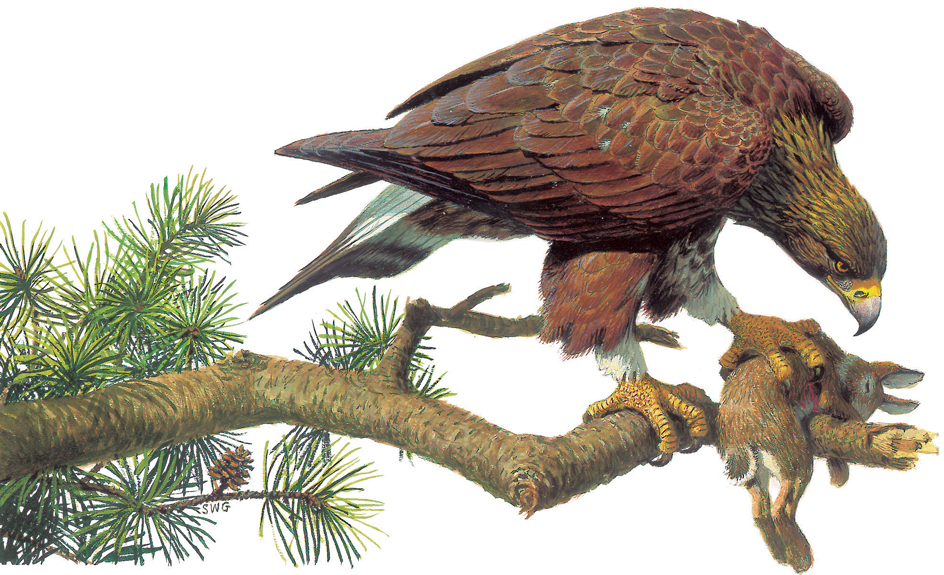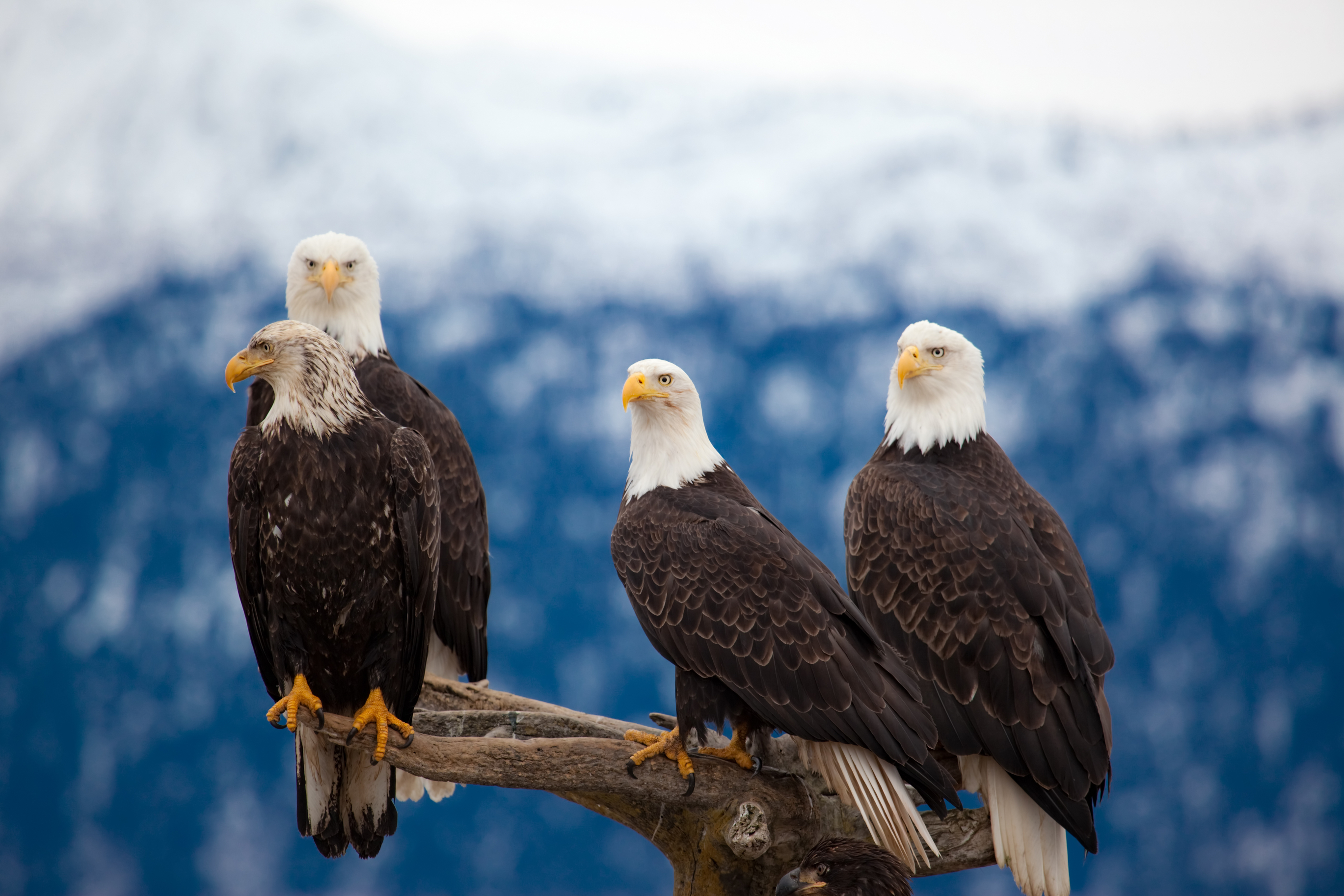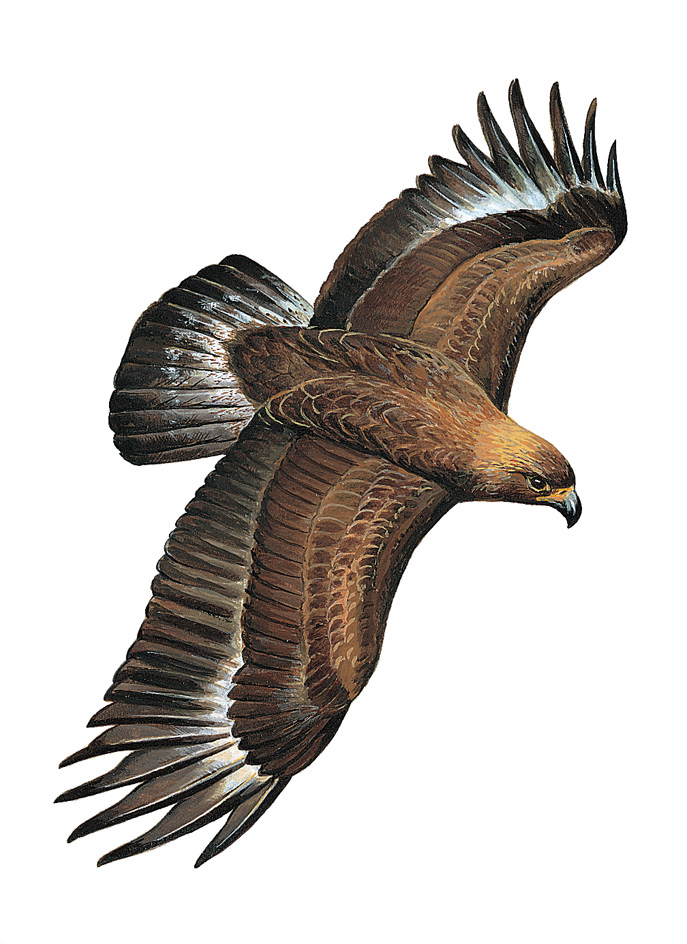Eagle is the name of some of the largest and most powerful birds in the world. Among birds of prey, only condors and some species of vultures grow larger than eagles. Eagles look fierce and proud, and they can soar gracefully high in the air. But eagles are not always as bold and fierce as they look. Many eagles, for example, get some of their food by scavenging for carrion (dead animals).

People have long admired eagles and adopted them as symbols of strength and bravery. Roman soldiers carried a golden figure of the eagle into battle. Russian and Austrian emperors also used eagles as symbols. The United States chose the bald eagle as its national bird in 1782. Eagles continue to serve as important symbols in many other countries, including Kazakhstan and Poland. Native Americans have used eagle feathers in traditional ceremonies for thousands of years.
The body of an eagle
Eagles vary in size by species (kinds) and among individuals. Females generally are larger than males. Wingspreads of different species range from about 3 to 8 feet (0.9 to 2.4 meters). Most eagles weigh about 7 to 12 pounds (3.2 to 5.4 kilograms), but some weigh as little as 1 pound (0.45 kilogram) and others weigh as much as 20 pounds (9.1 kilograms).
The head
of an eagle is large and covered with feathers. An eagle also has large eyes. Most birds have keener sight than do people, but eagles and their relatives are said to have the keenest sight of all. If a person could have eyesight as sharp as that of an eagle, he or she might be able to read a newspaper about 1 mile (1.6 kilometers) away. Eagles can sight their prey while soaring high in the air. But eagles usually watch their prey from perches or fly close to the ground while hunting. Eagles have large, strong, hooked beaks, which they use to tear up prey. The beak of the golden eagle measures about 2 inches (5 centimeters) long. The bald eagle’s beak grows even larger. The Steller’s sea-eagle and the Philippine eagle have some of the largest beaks of all eagles.
Loading the player...Bald eagle
Feet and legs.
Eagles have strong legs and feet covered in scaly, bright yellow skin. Eagles seize and kill prey with their long, curved talons (claws). They also use their talons to carry prey to a feeding place. When eagles fight, they dive at each other and try to wrestle with their talons. The lower legs of golden eagles and of several other species have a covering of feathers. Eagles with this covering are called booted eagles. The lower part of the bald eagle’s legs is not booted.
Feathers and wings.
Eagles have long tails and long, broad wings to support their heavy bodies when they fly. Eagles can glide great distances without flapping their wings. The long feathers on their wings are strong and stiff, and the feathers are shaped so the air flows smoothly over the surface of the wing. When the eagle soars, the feathers spread out like fingers, often bending up at the tips.
Adult eagles of most species are dark brown or black, but many have light-colored areas. Young eagles typically develop an adult color pattern between 4 and 6 years of age.
Loading the player...Eagle flying through the air
The life of an eagle
Wild eagles that survive to adulthood may live from 10 to 30 years. Some eagles can live even longer in captivity with a healthy diet and good veterinary care. Most eagles first breed when they reach about 5 years old. Mated eagles often stay together. If one member of a pair dies, the other may find another mate.

Nests
of eagles sometimes are called aeries or eyries << AIR eez or IHR eez >>. Bald eagles usually nest in the tops of tall trees that stand near water. Some build nests on cliffs. Golden eagles often nest on high cliffs in the mountains or in tall trees. Some eagles in Asia nest on the ground. Eagles tend to use the same nest every year. However, some eagles have two or more alternate nests. They may use one nest one year and another the next year.

Eagles build nests mainly with sticks, often adding fresh leaves and other foliage. The birds usually add new material each year they use a nest, so many old nests are huge. A new nest may measure 3 feet (0.9 meter) across and 18 inches (46 centimeters) deep. But an old one may reach 10 feet (3 meters) across and 15 feet (4.5 meters) deep. Some of these larger nests can weigh over 1 ton (0.9 metric ton).
Eggs.
Eagle eggs are about 3 inches (7.6 centimeters) long and 2 inches (5 centimeters) across. Females lay one to four eggs each year. Eagle eggs vary slightly in color. The eggs of golden eagles and their close relatives, for example, are white or spotted with reddish-brown or gray. Eggs of bald eagles and their close relatives are mostly white. Eagles lay their eggs at different times of the year. Birds from colder climates lay eggs in early spring, while those from warmer regions often do so during the late fall and the winter.
The eggs hatch in five to six weeks or more, depending on the species. In that time, the female incubates the eggs—that is, she sits on them to keep them warm. The male incubates them occasionally and brings food to the female while she sits. After the eggs hatch, both parents guard the nest and take food to the young.
Young eagles
are called eaglets or eyasses. Eaglets hatch with their eyes open and their bodies covered with grayish-white down (soft, fluffy feathers). Regular feathers begin to grow at 2 to 3 weeks of age. Eaglets cannot tear up their own food until they reach 5 to 7 weeks old. They leave the nest at 10 to 12 weeks but cannot fly well at first. They must stay near the nest and receive food from the parents for a few more months, until they can hunt well enough to get their own food.
Many kinds of eagles hatch two eggs. But in tropical species, only one eaglet usually survives. One eaglet often hatches two or three days before the other. The older one is larger and takes more than its share of food. It also might attack and even kill the other eaglet, sometimes eating it.
Food.
Eagles hunt during the day and at dawn and dusk. They spend the night in their nests or on a safe perch. Two eagles, especially a mated pair, may hunt together. Some eagles eat only certain types of prey. But most hunt a wide variety of prey and occasionally eat carrion or steal prey from other animals.
The golden eagle eats rabbits, hares, ground squirrels, and birds. It may also eat carrion. The golden eagle usually flies low over open hillsides, dropping down quickly to seize its startled prey.
The bald eagle eats fish, other birds, and carrion. It hunts primarily by watching for prey from a perch. It snatches fish from the water while flying. If pulled into the water by its catch, a bald eagle can swim to shore with the catch by floating and using a rowing motion with its wings. It sometimes takes fish away from other birds, such as gulls and ospreys. Occasionally, bald eagles catch coots and other water birds by hovering over them and forcing them to dive repeatedly until they are exhausted. In addition, the eagles sometimes catch birds in the air with spectacular aerial maneuvering. Bald eagles may also capture mammals and often eat carrion.
Kinds of eagles
There are more than 60 species of eagles. Most are native to tropical regions, particularly in Africa and Asia. Only the bald eagle and the golden eagle are native to North America.
The bald eagle
is not really bald. Its head has a covering of white feathers, and its tail feathers are white. A young bald eagle is dark brown and has scattered light markings. The bald eagle lives only in North America.
In winter, bald eagles may gather in large numbers in areas with plentiful food. For example, the Mississippi River around Iowa and the Chesapeake Bay area in the eastern United States both support large winter gatherings of eagles. During the breeding season, however, each pair of eagles claims a territory around its nest and keeps other eagles away.
Until the mid-1900’s, hunters and trappers killed large numbers of bald eagles. United States federal law has protected the species since 1940 in the lower 48 states and since 1959 in Alaska. However, the continued shooting and trapping of the birds, as well as accidental collisions with vehicles, caused further population declines. The number of bald eagles also dropped because of the pollution of lakes and rivers with pesticides, especially DDT, and industrial wastes. Although DDT is an agricultural pesticide typically sprayed on crops, it was carried into waterways in drainage. There, it eventually began to build up in the bodies of fish. When bald eagles ate fish, the DDT did not hurt the adults, but it caused the females to lay eggs with thin shells, resulting in the loss of multiple generations of offspring. By 1963, there were fewer than 500 breeding pairs of bald eagles making nests in the lower 48 states.
Loading the player...
Bald eagle

Since then, however, the bald eagle has made a remarkable comeback. The U.S. government has implemented strict regulations to protect eagles from harmful chemical wastes—including a ban on the use of DDT—and to prevent the illegal hunting or trapping of eagles. The United States, Canada, and Mexico have worked together, in part through the Migratory Bird Treaty Act of 1918, to protect birds such as bald eagles that migrate across international borders. Conservation groups have restocked former nesting areas with young eagles. Bald eagles also have become more accustomed to people and now often nest in nonwilderness areas close to human activity. Today, more than 316,000 bald eagles live in the lower 48 states, and they are increasing in number. Some biologists estimate that as many as 500,000 bald eagles may inhabit Canada and Alaska.
The golden eagle
is dark brown with a patch of golden brown feathers on the back of its neck. A young golden eagle has dark plumage with white patches on its wings and tail. Golden eagles live in Europe, Asia, northern Africa, and much of North America. The native Plains people once used golden eagle feathers in their bonnets, and the golden eagle became known as the “war eagle.” Some golden eagles migrate south to spend the winter in the southwestern United States and Mexico. Many golden eagles have been killed by sheep ranchers who feared the birds would kill young lambs. In Texas in the 1940’s, for example, hired hunters shot thousands of these birds from airplanes. Federal law has protected the golden eagle since 1962. But some birds probably still fall victim to illegal shootings.
Loading the player...Golden eagle
Other kinds of eagles
include the white-tailed eagle and Steller’s sea-eagle. Both are closely related to the bald eagle and have similar habits. The white-tailed eagle breeds in many parts of Asia and mainland Europe, and in Iceland and Greenland. It has a white tail like the bald eagle, but its head is dark. Steller’s sea-eagle is dark, except for a white tail and white shoulders. It ranks as one of the largest and most powerful of all eagles. It breeds on the Pacific coast of Siberia and in North and South Korea, and it sometimes visits the Aleutian Islands near Alaska.

The harpy eagle of tropical Central and South America is another of the world’s largest and strongest eagles. It lives in dense rain forests. The harpy eagle preys on capuchin monkeys, sloths, and other mammals. It is black and white with a gray head and a long, black crest. The harpy eagle raises one eaglet at a time, and feeds it for nearly a year after it hatches. The parents probably breed only once every two years.

The Philippine eagle, found only in the Philippines, looks much like the harpy eagle and lives in much the same way. It eats monkeys and other mammals, as well as large birds and reptiles. It builds its nest in large trees in rain forests. These eagles are becoming scarce because hunters shoot many of them, and other people cut down the birds’ rain forest habitats. The crowned eagle of Africa also inhabits rain forests and eats monkeys.
The martial eagle, another of the largest eagles, lives in the grassy plains of Africa. It eats small ungulates (hoofed mammals) and rodents. The African fish-eagle, a relative of the bald eagle, lives beside lakes and rivers. It makes a wild, screaming call with its head turned far back over its shoulders.

The white-bellied fish-eagle of southern Asia and Australia is a gray-and-white bird that lives on tropical coasts. It eats fish and sea snakes, snatching them from the sea with its talons. The serpent-eagles and snake-eagles of Africa, Asia, and Europe reside in the tops of tall trees. They eat snakes and lizards. The steppe eagle of central Asia lives on treeless plains. It sometimes nests on the ground. Many types of eagles from Europe and western Asia, including some steppe eagles, migrate to Africa each winter. Great flocks of them fly over Egyptian deserts every spring and fall.
Eagles and people
Eagles usually stay away from human beings. However, eagles defend their nests and have swooped at people. As eagle populations have increased in eastern North America, eagles and humans interact more frequently. This closeness provides people with exciting opportunities for viewing eagles. Bald eagles sometimes even build their nests in the yards of people who live near water.
Eagles worldwide are threatened by a range of problems. The Philippine eagle is one of the rarest birds in the world. It lives only on a few of the Philippine islands. It is threatened by habitat loss and being killed by humans. Historically, many eagles were threatened by poisoning from DDT. Bald eagles were once common in eastern North America, but they were driven almost to extinction because of DDT’s negative effects on reproduction. However, since the banning of this pesticide in the 1970’s, bald eagle populations have made a dramatic recovery. Wind turbines are also a threat to eagles, which can be killed in collisions with the spinning blades. Eagles are also threatened by lead poisoning and other factors related to human activity.
